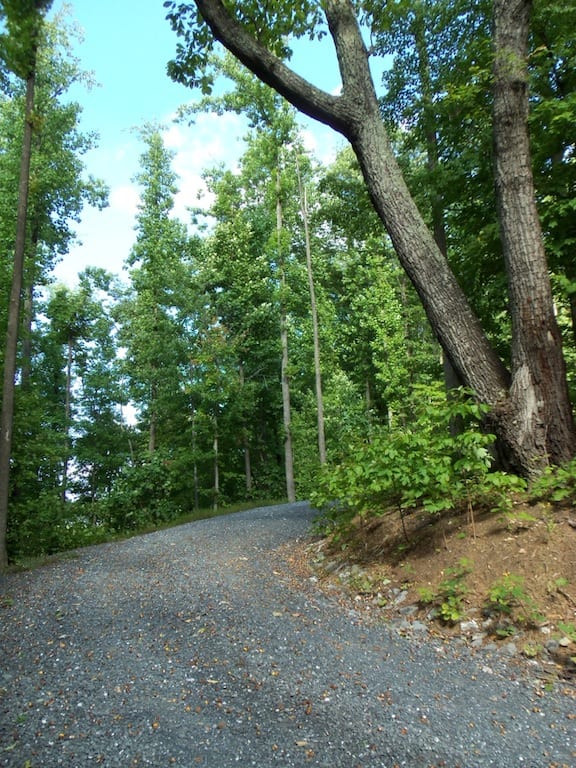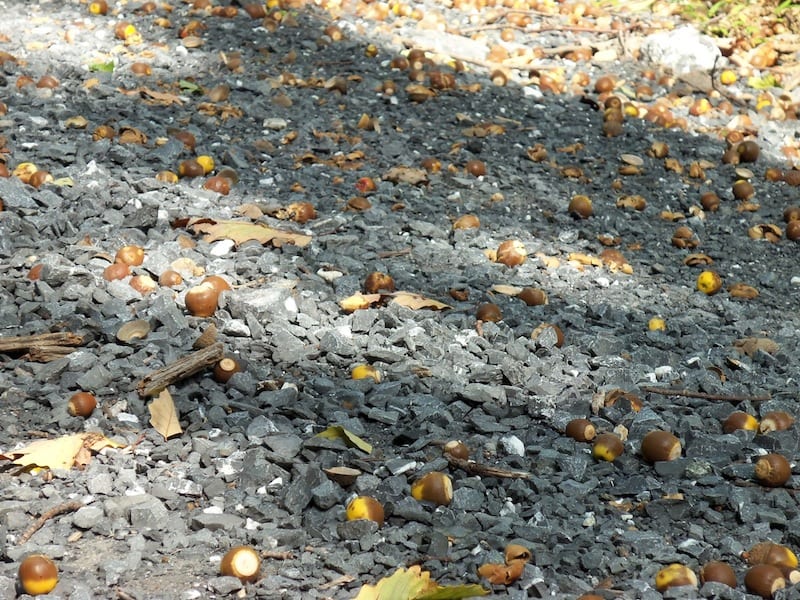Three years ago, the red oak trees here at Vanaprastha produced a bumper crop of acorns. When the wind blew, acorns peppered the deck and roof like hail stones. Keith and I thought this was a response to the disruption of building the house, as if the Oaks were saying, “Oh, yeah? Well, take that!” After doing a little research, I discovered that oak trees have acorn bust and boom times, the latter called mast years.
 This fall is a mast year for the Oaks. When we sit on the deck or work outside, we hear an almost constant symphony of acorns falling in the forest. It’s a startling sound amid the quiet that ordinarily surrounds us. Hiking down the driveway can be treacherous, like walking on marbles. According to a blogger for Mass Audubon, in mast years a large oak like one of ours pictured here might produce 10,000 acorns.
This fall is a mast year for the Oaks. When we sit on the deck or work outside, we hear an almost constant symphony of acorns falling in the forest. It’s a startling sound amid the quiet that ordinarily surrounds us. Hiking down the driveway can be treacherous, like walking on marbles. According to a blogger for Mass Audubon, in mast years a large oak like one of ours pictured here might produce 10,000 acorns.
2014 marks a mast year for me, too. This week, another draft of my manuscript reaches completion and sails off to my editor. Thus ends several months of falling, as in Richard Rohr’s Falling Upward. I thought the fall was over when I wrote this post last spring. Alas and hurrah, I now know I was only mid-fall, with 5,000 acorns rolling under my feet and another 5,000 ready to hit me on the head. Falling is a troubling and mystical experience, like simultaneously rending the garment of your life and weaving growth into the fabric and stitching your life back together again.
Mast years occur every 2-5 years for Oaks, but what triggers the cycles remains a mystery. Researchers have determined that acorn production is not related to weather conditions – not spring rains or drought, high or low temperatures – and does not predict either a mild or severe winter. Other environmental explanations show only weak correlations.
My falls seem to occur every 20 years according to the seasons of life – spring, summer and now autumn. The first happened in college, but I was too immature to produce more than a nutshell paragraph, or nutgraf, and then keep going. After my marriage failed when I turned 40, another fall happened. That got my attention and resulted in significant growth benefits. I’m not entirely sure what triggered this fall in my 60s – probably many factors. Some I sorted out while writing the story and others I do not suppose I’ll ever know, at least not in this life.
 One thing for sure about Oaks, the cycles advantage the trees’ reproductive survival through what’s called ‘predator satiation.’ Animals such as chipmunks, squirrels, turkeys, deer, bear and mice can’t eat all the acorns during a boom year. Thus, some acorns are left to grow into Oaks. And fewer acorns during the bust years mean less for animals to eat, which lowers their populations before the Oaks’ mast years.
One thing for sure about Oaks, the cycles advantage the trees’ reproductive survival through what’s called ‘predator satiation.’ Animals such as chipmunks, squirrels, turkeys, deer, bear and mice can’t eat all the acorns during a boom year. Thus, some acorns are left to grow into Oaks. And fewer acorns during the bust years mean less for animals to eat, which lowers their populations before the Oaks’ mast years.
The locals here say we’re in for another severe winter. I wonder, if I live long enough to cycle into a winter fall, will it be mild or severe? Alas and hurrah, both this coming winter and mine remain a mystery.



Love this meditation on the acorns of oak trees and the falls of life that often amount to mighty creativity. I think your memoir about Honesty, Love, and Lies is a sturdy oak that many will enjoy climbing.
Thank you so much for journeying with me!